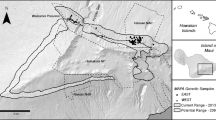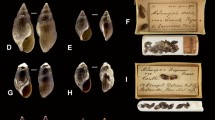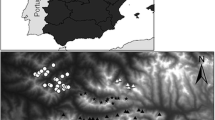Abstract
Esox flaviae represents the native esocid species of the Italian peninsula at present potentially highly threatened by the diffusion of exotic E. lucius. Here, we present a novel mtDNA (N = 272) and microsatellite (N = 275) dataset including 13 test and 3 reference samples, aimed to delineate the distribution of the native as well as the exotic species and to unravel potential introgressive hybridisation between the two species in Northern Italy. We highlight a complex mosaic distribution of both species, with contrasting occurrence even between neighbouring sites. Significant genetic substructure is still observed within E. flaviae, while the dispersal of the invader seems to be promoted by restocking actions. In addition, we prove the existence of introgressive hybridisation between native and exotic pikes. Here, gender-biased hybridisation is suggested, with native E. flaviae constituting the predominant ‘mother species’ in the hybridisation process. Finally, we underline the need for a revision of fisheries management regulations, for which a nation-wide and exhaustive genetic screening in the near future should build the scientific basis.





Similar content being viewed by others
References
Aguilar, A., J. D. Banks, K. F. Levine & R. K. Wayne, 2005. Population genetics of northern pike (Esox lucius) introduced into Lake Davis, California. Canadian Journal of Fisheries and Aquatic Sciences 62: 1589–1599.
Akaike, H., 1974. A new look at the statistical model identification. IEEE Transactions on Automatic Control 19: 716–723.
Allendorf, F. W. & G. Luikart, 2007. Conservation and the Genetics of Populations. Blackwell Publishing, Oxford.
Anderson, E. C. & E. A. Thompson, 2002. A model-based method for identifying species hybrids using multilocus genetic data. Genetics 160: 1217–1229.
Baars, M., E. Mathes, H. Stein, & U. Steinhörster, 2001. Die Äsche. Die Neue Brehm-Bücherei, Westarp Wissenschaften, Hohenwarsleben
Bandelt, H. J., P. Forster & A. Röhl, 1999. Median-joining networks for inferring intraspecific phylogenies. Molecular Biology and Evolution 16: 37–48.
Bekkevold, D., L. Jacobsen, J. Hemmer-Hansen, S. Berg & C. Skov, 2015. From regionally predictable to locally complex population structure in a freshwater top predator: river systems are not always the unit of connectivity in Northern Pike Esox Lucius. Ecology of Freshwater Fish 24: 305–316.
Belkhir, K., P. Borsa, L. Chikhi, N. Raufaste & F. Bonhomme, 1996–2004. GENETIX 4.05, logiciel sous Windows TM pour la génétique des populations. Laboratoire Génome, Populations, Interactions, CNRS UMR 5000, Université de Montpellier II, Montpellier, France.
Bianco, P. G., 2014. An update on the status of native and exotic freshwater fishes of Italy. Journal of Applied Ichthyology 30: 62–77.
Bianco, P. G. & G. B. Delmastro, 2011. Recenti novità tassonomiche riguardanti i pesci d’acqua dolce autoctoni in Italia e descrizione di una nuova specie di luccio. Researches on Wildlife Conservation, vol 2 (suppl.), IGF Publishing, USA, pp. 14.
Crossman, E. J. & K. Buss, 1965. Hybridization in the family Esocidae. Journal of the Fisheries Research Board of Canada 22: 1261–1292.
Darriba, D., G. L. Taboada, R. Doallo & D. Posada, 2012. jModelTest 2: more models, new heuristics and parallel computing. Nature Methods 9: 772.
Delmastro, G. B., G. Boano, P. Lo Conte & S. Fenoglio, 2015. Great cormorant predation on Cisalpine pike: a conservation conflict. European Journal of Wildlife Research 61: 743–748.
Denys, G. P. J., A. Dettai, H. Persat, M. Hautecoeur & P. Keith, 2014. Morphological and molecular evidence of three species of pikes Esox spp. (Actinopterygii, Esocidae) in France, including the description of a new species. Comptes Rendus Biologies 337: 521–534.
Earl, D. A. & B. M. vonHoldt, 2012. STRUCTURE HARVESTER: a website and program for visualizing STRUCTURE output and implementing the Evanno method. Conservation Genetics Resources 4: 359–361.
Epifanio, J. & D. Philipp, 2001. Simulating the extinction of parental lineages from introgressive hybridization: the effects of fitness, initial proportions of parental taxa, and mate choice. Reviews in Fish Biology and Fisheries 10: 339–354.
Eschbach, E. & S. Schoning, 2013. Identification of high-resolution microsatellites without a priori knowledge of genotypes using a simple scoring approach. Methods in Ecology and Evolution 4: 1076–1082.
Evanno, G., S. Regnaut & J. Goudet, 2005. Detecting the number of clusters of individuals using the software STRUCTURE: a simulation study. Molecular Ecology 14: 2611–2620.
Excoffier, L. & H. E. L. Lischer, 2010. Arlequin suite ver 3.5: a new series of programs to perform population genetics analyses under Linux and Windows. Molecular Ecology Resources 10: 564–567.
Excoffier, L. & M. Slatkin, 1998. Incorporating genotypes of relatives into a test of linkage disequilibrium. The American Journal of Human Genetics 62: 171–180.
Felsenstein, J., 1985. Confidence limits on phylogenies: an approach using the bootstrap. Evolution 39: 783–791.
Gandolfi, A., D. Fontaneto, M. Natali & L. Lucentini, 2016. Mitochondrial genome of Esox flaviae (Southern pike): announcement and comparison with other Esocidae. Mitochondrial DNA Part A 27: 3037–3038.
Genovesi, P., P. Angelini, E. Bianchi, E. Dupré, S. Ercole, V. Giacanelli, F. Ronchi & F. Stoch, 2014. Specie e habitat di interesse comunitario in Italia: distribuzione, stato di conservazione e trend. ISPRA, Serie Rapporti, 194/2014.
Goudet, J., 1995. FSTAT (Version 1.2): a computer program to calculate F-statistics. Journal of Heredity 86: 485–486.
Gozlan, R. E., D. Andreou, T. Asaeda, K. Beyer, R. Bouhadad, D. Burnard, N. Caiola, P. Cakic, V. Djikanovic, H. R. Esmaeili, I. Falka, D. Golicher, A. Harka, G. Jeney, V. Kováč, J. Musil, A. Nocita, M. Povz, N. Poulet, T. Virbickas, C. Wolter, A. S. Tarkan, E. Tricarico, T. Trichkova, H. Verreycken, A. Witkowski, C. G. Zhang, I. Zweimueller & J. R. Britton, 2010. Pan-continental invasion of Pseudorasbora parva: towards a better understanding of freshwater fish invasions. Fish & Fisheries 11: 315–340.
Gratton, P., G. Allegrucci, A. Gandolfi & V. Sbordoni, 2013. Genetic differentiation and hybridization in two naturally occurring sympatric trout Salmo spp. forms from a small karstic lake. Journal of Fish Biology 82: 637–657.
Guindon, S., J. F. Dufayard, V. Lefort, M. Anisimova, W. Hordijk & O. Gascuel, 2010. New algorithms and methods to estimate maximum-likelihood phylogenies: assessing the performance of PhyML 3.0. Systematic Biology 59: 307–321.
Guo, S. W. & E. A. Thompson, 1992. Performing the exact test of Hardy-Weinberg proportions for multiple alleles. Biometrics 48: 361–372.
Hansen, M. M., J. B. Taggart & D. Meldrup, 1999. Development of new VNTR markers for pike and assessment of variability at di- and tetranucleotide repeat microsatellite loci. Journal of Fish Biology 55: 183–188.
Hansen, M. M., D. E. Ruzzante, E. E. Nielsen & K.-L. D. Mensberg, 2001. Brown trout (Salmo trutta) stocking impact assessment using microsatellite DNA markers. Ecological Applications 11: 148–160.
Harvey, B., 2009. A biological synopsis of northern pike (Esox lucius). Manuscript Report of Fisheries and Aquatic Sciences, 2885.
Hermoso, V. & M. Clavero, 2011. Threatening processes and conservation management of endemic freshwater fish in the Mediterranean basin: a review. Marine and Freshwater Research 62: 244–254.
Holleley, C. E. & P. G. Geerts, 2009. Multiplex Manager 1.0: a crossplatform computer program that plans and optimizes multiplex PCR. BioTechniques 46: 511–517.
Huhn, D., K. Lubke, C. Skov & R. Arlinghaus, 2014. Natural recruitment, density-dependent juvenile survival, and the potential for additive effects of stock enhancement: an experimental evaluation of stocking northern pike (Esox lucius) fry. Canadian Journal of Fisheries and Aquatic Sciences 71: 1508–1519.
Huson, D. H. & D. Bryant, 2006. Application of phylogenetic networks in evolutionary studies. Molecular Biology and Evolution 23: 254–267.
Ketmaier, V. & P. G. Bianco, 2015. Understanding and conserving genetic diversity in a world dominated by alien introductions and native transfers: the case study of primary and peripheral freshwater fishes in southern Europe. In Closs, G. P., M. Krkosek & J. D. Olden (eds), Conservation of Freshwater Fishes. Cambridge University Press, Cambridge: 506–534.
Kottelat, M. & J. Freyhof, 2007. Handbook of European Freshwater Fish. Kottelat, Freyhof, Cornol and Berlin.
Laikre, L., L. M. Miller, A. Palmé, S. Palm, A. R. Kapuscinski, G. Thoresson & N. Ryman, 2005. Spatial genetic structure of northern pike (Esox lucius) in the Baltic Sea. Molecular Ecology 14: 1955–1964.
Larkin, M. A., G. Blackshields, N. P. Brown, R. Chenna, P. A. McGettigan, H. McWilliam, F. Valentin, I. M. Wallace, A. Wilm, R. Lopez, J. D. Thompson, T. J. Gibson & D. G. Higgins, 2007. Clustal W and Clustal X version 2.0. Bioinformatics 23: 2947–2948.
Larsen, P. F., M. M. Hansen, E. E. Nielsen, L. F. Jensen & V. Loeschcke, 2005. Stocking impact and temporal stability of genetic composition in a brackish northern pike population (Esox lucius L.), assessed using microsatellite DNA analysis of historical and contemporary samples. Heredity 95: 136–143.
Launey, S., F. Krieg, J. Morin & J. Laroche, 2003. Five new microsatellite markers for northern pike (Esox lucius). Molecular Ecology Notes 3: 366–368.
Launey, S., J. Morin, S. Minery & J. Laroche, 2006. Microsatellite genetic variation reveals extensive introgression between wild and introduced stocks, and a new evolutionary unit in French pike Esox lucius L. Journal of Fish Biology 68: 193–216.
Lucentini, L., A. Palomba, L. Gigliarelli, H. Lancioni, M. Natali & F. Panara, 2006. Microsatellite polymorphism in Italian populations of northern pike (Esox lucius L.). Fisheries Research 80: 251–262.
Lucentini, L., A. Palomba, L. Gigliarelli, G. Sgaravizzi, H. Lancioni, L. Lanfaloni, M. Natali & F. Panara, 2009. Temporal changes and effective population size of an Italian isolated and supportive-breeding managed northern pike (Esox lucius) population. Fisheries Research 96: 139–147.
Lucentini, L., M. E. Puletti, C. Ricciolini, L. Gigliarelli, D. Fontaneto, L. Lanfaloni, F. Bilò, M. Natali & F. Panara, 2011. Molecular and phenotypic evidence of a new species of genus Esox (Esocidae, Esociformes, Actinopterygii): the Southern pike, Esox flaviae. PLoS ONE 6: e25218.
Maes, G. E., J. K. J. Van Houdt, D. De Charleroy & F. A. M. Volckaert, 2003. Indications for a recent Holarctic expansion of pike based on a preliminary study of mtDNA variation. Journal of Fish Biology 63: 254–259.
McKelvey, K. S., M. K. Young, T. M. Wilcox, D. M. Bingham, K. L. Pilgrim & M. K. Schwartz, 2016. Patterns of hybridization among cutthroat trout and rainbow trout in northern Rocky Mountain streams. Ecology and Evolution 6: 688–706.
Meraner, A., A. Venturi, G. F. Ficetola, S. Rossi, A. Candiotto & A. Gandolfi, 2013a. Massive invasion of exotic Barbus barbus and introgressive hybridization with endemic Barbus plebejus in Northern Italy: where, how and why? Molecular Ecology 22: 5295–5312.
Meraner, A., G. Unfer & A. Gandolfi, 2013b. Good news for conservation: limited genetic signatures of inter-basin fish transfer in Thymallus thymallus (Salmonidae) from the Upper Drava River. Knowledge and Management of Aquatic Ecosystems 409: 1–17.
Meraner, A., P. Gratton, F. Baraldi & A. Gandolfi, 2013c. Nothing but a trace left? Autochthony and conservation status of Northern Adriatic Salmo trutta inferred from PCR multiplexing, mtDNA control region sequencing and microsatellite analysis. Hydrobiologia 702: 201–213.
Meraner, A., L. Cornetti & A. Gandolfi, 2014. Defining conservation units in a stocking-induced genetic melting pot: unraveling native and multiple exotic genetic imprints of recent and historical secondary contact in Adriatic grayling. Ecology and Evolution 4: 1313–1327.
Miller, L. M. & A. R. Kapuscinski, 1997. Historical analysis of genetic variation reveals low effective population size in a northern pike (Esox lucius) population. Genetics 147: 1249–1258.
Miller, L. M. & W. Senanan, 2003. A review of northern pike population genetics research and its implications for management. North American Journal of Fisheries Management 23: 297–306.
Nicod, J.-C., Y. Z. Wang, L. Excoffier & C. R. Largiader, 2004. Low levels of mitochondrial DNA variation among central and southern European Esox lucius populations. Journal of Fish Biology 64: 1442–1449.
Pedreschi, D., M. Kelly-Quinn, J. Caffrey, M. O’Grady & S. Mariani, 2014. Genetic structure of pike (Esox lucius) reveals a complex and previously unrecognized colonization history of Ireland. Journal of Biogeography 41: 548–560.
Pritchard, J., M. Stephens & P. Donnelly, 2000. Inference of population structure using multilocus genotype data. Genetics 155: 945–959.
Roberts, D. G., C. A. Gray, R. J. West & D. J. Ayre, 2010. Marine genetic swamping: hybrids replace an obligately estuarine fish. Molecular Ecology 19: 508–520.
Rondinini, C., A. Battistoni, V. Peronace & C. Teofili, 2013. Lista Rossa IUCN dei Vertebrati Italiani. Comitato Italiano IUCN e Ministero dell’Ambiente e della Tutela del Territorio e del Mare, Roma, pp. 54.
Seeb, J. E., L. W. Seeb, D. W. Oates & F. M. Utter, 1987. Genetic variation and postglacial dispersal of populations of northern pike (Esox lucius) in North America. Canadian Journal of Fisheries and Aquatic Sciences 44: 556–561.
Senanan, W. & R. Kapuscinski, 2000. Genetic relationships among populations of northern pike (Esox lucius). Canadian Journal of Fisheries and Aquatic Sciences 57: 391–404.
Skog, A., L. Vøllestad, N. Stenseth, A. Kasumyan & K. Jakobsen, 2014. Circumpolar phylogeography of the northern pike (Esox lucius) and its relationship to the Amur pike (E. reichertii). Frontiers in Zoology 11: 67.
Sloss, B. L., R. P. Franckowiak & E. L. Murphy, 2008. Development of new microsatellite loci and multiplex reactions for muskellunge (Esox masquinongy). Molecular Ecology Resources 8: 811–813.
Smith, K. G. & W. R. T. Darwall, 2006. The status and distribution of freshwater fish endemic to the Mediterranean Basin. IUCN, Gland.
Storey, J. D., 2002. A direct approach to false discovery rates. Journal of the Royal Statistical Society Series B 64: 479–498.
Sušnik Bajec, S., G. Pustovrh, D. Jesenšek & A. Snoj, 2015. Population genetic SNP analysis of marble and brown trout in a hybridization zone of the Adriatic watershed in Slovenia. Biological Conservation 184: 239–250.
Vähä, J. P. & C. R. Primmer, 2006. Efficiency of model-based Bayesian methods for detecting hybrid individuals under different hybridization scenarios and with different numbers of loci. Molecular Ecology 15: 63–72.
Wang, J., C. Wang, L. Qian, Y. Ma, X. Yang, Z. Jeney & S. Li, 2011. Genetic characterization of 18 novel microsatellite loci in northern pike (Esox lucius L.). Genetics and Molecular Biology 34: 169–172.
Young, W. P., C. O. Ostberg, P. Keim & G. H. Thorgaard, 2001. Genetic characterization of hybridization and introgression between anadromous rainbow trout (Oncorhynchus mykiss irideus) and coastal cutthroat trout (O. clarki clarki). Molecular Ecology 10: 921–930.
Acknowledgements
The authors are grateful to Fisheries Offices (H. Erhard and H. Grund, Autonomous Provinces of Bolzano/Bozen; S. Filippini and R. Sala, Province of Lodi), researchers (E. Eschbach, Leibniz-Institute for Freshwater Ecology and Inland Fisheries, Department of Biology and Ecology of Fishes; T. Friedrich and G. Unfer, BOKU Vienna – University of Natural Resources and Life Sciences, Institute for Hydrobiology and Aquatic Ecosystem Management), free-lance ichthyologists (L. Betti; S. Rossi), professional fishermen (A. Andreis) and anglers (W. Arnoldo; Fisheries Association of Appiano/Eppan) who contributed to the collection of tissue samples.
Author information
Authors and Affiliations
Corresponding author
Additional information
Handling editor: Christian Sturmbauer
An erratum to this article is available at http://dx.doi.org/10.1007/s10750-017-3250-z.
Electronic supplementary material
Below is the link to the electronic supplementary material.
10750_2016_3083_MOESM1_ESM.pdf
NewHybrids analysis on a simulated dataset including individuals of E. lucius, E. flaviae and different hybrid classes (F1, F2 and backcrosses to E. lucius and E. flaviae). Supplementary material 1 (PDF 106 kb)
Rights and permissions
About this article
Cite this article
Gandolfi, A., Ferrari, C., Crestanello, B. et al. Population genetics of pike, genus Esox (Actinopterygii, Esocidae), in Northern Italy: evidence for mosaic distribution of native, exotic and introgressed populations. Hydrobiologia 794, 73–92 (2017). https://doi.org/10.1007/s10750-016-3083-1
Received:
Revised:
Accepted:
Published:
Issue Date:
DOI: https://doi.org/10.1007/s10750-016-3083-1




